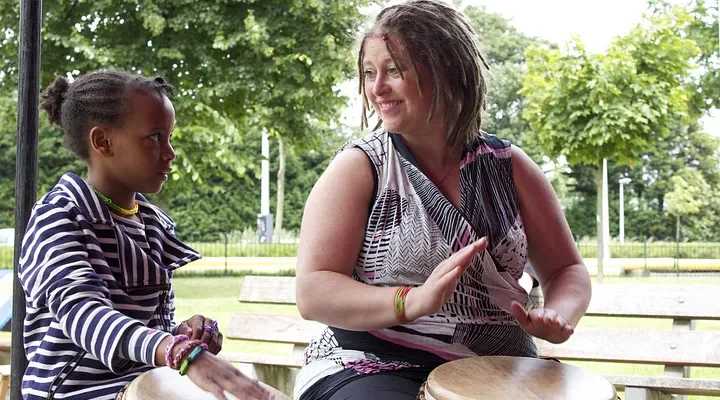Djembe is one of the most famous musical instruments in the world. Percussion instruments of this handmade of wood made perforated on the inside and then covered with leather. Banama tribe from Mali said if that Djembe is derived from Anke Dje, Anke Be which means people meet with peace. This Djembe instrument is played in a traditional way, used to be played during traditional African ceremonies such as weddings, baptisms, births, and other traditional ceremonies. This instrument also has a unique function such as a sign that the war will begin and as a means of communication between tribes because the distance between villages has a long distance. This hand drum is related to the spiritual. There are 3 spirits of djembe in it that are the wood that has the meaning of power, the skin of the animal has a symbol of prosperity and peace, Djembe user is a symbol of the spirit. In the past when cutting trees Djem to be used as musical instruments there must be a ritual. The strap used is usually alpine/rasta rope. Good skin for the manufacture of this instrument is cowhide, antelope, and goat.

In 1950 the African theater popularized this instrument to the European continent. A lot of music can collaborate within musical instruments such as Reggae, Pop and Rock music genres. Djembe is played very simply, using only simple hands and techniques. Everyone can play it. This African drum has some rhythmic patterns of the game that has a thundering sound, has a very treble voice and a very noisy voice that evokes spiritual energy in the primitive ritual of the past. Many musical instruments like Djembe, such as Sangba, Yimbei, Jimberu, Bata, Tapoi and other musical instruments. They play it in groups with different tribes.
Here is a traditional way for the African tribe when making Djembe.
1. Choose a good Djem tree for African drum making materials.
2. Perform special rituals before cutting down trees, begging the smoothness of the making and to produce a good sound.
3. Cut trees that have been selected and that have been rituals.
4. Measure the length of the wood and cut it to size.
5. The outside wood is exfoliated using a sharp knife, large and exfoliated to leave the white part of the wood.
6. The lathe process is to form the wood to shape the shape of Djembe.
7. Dry the finished wood in the process of lathing in the sun.
8. After the dry wood, pure the surface by sand.
9. Process add carvings and can also draw interesting motifs on this hand drum.
Installation of leash and leather, in this process you must be careful to lock, connect the rope to the skin and use a circular iron in diameter. When all the processes have been done, the last drying Djembe and this instrument are ready for use. The making of African native hand drums is indeed complicated, but the sound produced is very good and able to evoke spiritual value. The stretching technique is done after the drum is dry, you must be painstaking and fasten it with string. The person who plays Djembe is often referred to by the term “Djembe Fola”. If you want to quickly learn to play this instrument, you have to learn regularly. If you do not have this hand drum you can borrow it from your friend. Spend a few hours each day, you can also see an example of playing Djembe music over the internet and if any of your friends can play it you can also ask your friends to teach it. After that, you can have a Djembe which will certainly help you in learning how to play. You can find a good quality Djembe and many other types of musical instruments in our trusted African drum wholesale manufacturer namely Bali Treasures Drum Factory.
There are some simple ways to play Djembe that you can try at home:
1. The sound “tung” or slap, is hitting the edge of Djembe with a distance of about 5 cm.
2. The sound “dung” is produced by hitting the middle of the membrane using one hand.
3. The sound “tak” is a way of placing one solder in the middle of the Djembe membrane with the vertical upward hand position, then the other hand performing the “slap” sound technique.

The above is very simple that only uses the hand as the medium. You can choose and have this special hand drum in Bali Treasures. Our hand percussion manufacturer is located in Andong High Way, Peliatan Ubud, Bali. We have been there since 1998 and have experienced making hand percussion instruments. We are also a hand drum specialist producing 200 types of percussion instruments. We have many awards given by the Indonesian government. We also participate in forest conservation in Indonesia. The workers at Bali Drum Factory have experienced and of course, the result is very good. We also have exported many products to several countries in the world. They are satisfied with our products. You can see many kinds of hand percussion products are quality and have many motives. You can contact us by email at marketing@bali-treasures.com and also contact us by phone: 0361 978 637.



